Luminance, luminous intensity, and how we see light sources (taillamps and headlamps)
- Introduction
- 3 types of emitters
- Situation 1: A light source that has a fairly big emitting surface
- Situation 2: A light source that emits truly parallel light (this is what lasers can do)
- Situation 3: A point source
- The 3 different types compared with some example calculations of the lux values
- Why luminance and luminous intensity are not of interest at long distance
- Difference of light intensities is the main problem in getting blinded
- Physiological
- Psychological
- Result: Dual blinding
- Conclusion
For taillamps but also headlamps luminance is an issue in how visible but also how annoying a lamp is. Luminance is the emitted light divided by the surface area of the emitter, of which the unit is lux. Note that this doesn't change depending on distance.
However, I said on the main page that distance is the issue, because of the light intensity in lux dropping off with the inverse square of the distance, and this is also true. The amount of light that is received by the eye is after all dependant on how far away you are, so despite high luminance, the experienced light intensity will at some point drop to where it doesn't annoy any more. Even peak values in a beam are at long distances not an issue then because of the finite size of photoreceptors, the lens not being perfect etc. This relation of incoming light being inversely proportional to the square of the distance (which is related to the size of the emitter and thus the projection of that light onto the retina) is also why luminance is stated to be mainly of use for emitters that are reasonably large, for smaller emitters and especially point sources, the luminous intensity is what matters (luminous intensity is the emitted light in a given direction per space-angle, of which the unit is candela, note that the luminous intensity doesn't depend on distance, you can envision it as a cone of light, the light may get spread out over a larger area, but the space angle of that area is still the same). This is because of how we see what we see, namely, with lenses, and the pictures below will explain what happens. The inverse square is less of a factor in lamps with bigger emitting surface, because the virtual point source lies a fair distance behind the lamp and thus intensity will both not drop as much in strength at big distances, nor get as high at short distances. Whether you talk in lux or luminous intensity doesn't matter much then, except to clarify exactly to those want to know the details.
So in effect what I wrote on the main page was correct. Some people who know more of the matter may read it differently than it is meant (although they should be able to figure it out) and explaining it in more detail costs a lot of space and makes things far less clear to the layman. But I suppose this is the problem in these matters, the subject is complicated, and explaining it simply needs a lot of steps, space, pictures, and of course time to write the text explaining it, which is why I only now (Oct. 2013) got round to writing it all up, though I had prepared most of it a year ago and the pictures below are from Feb. 2013. Aaah, time flies when you have to do other things...
2013-12-8: An addition giving the reason why at longer distance the luminance (and close-range measurement of luminous intensity in any specific given direction, I will add a picture of what I mean for this as it was apparantly unclear (namely: The cone of light can have light going in other directions... unless measured at largish distance so such effects are not a big influence)) is not of interest any more in determining visibility (so lux will do just as well), see after the discussion of the various situations. I mentioned some of these reasons already in an email early 2013 about luminance, finally got round to putting it on my site :)
3 types of emitters
Situation 1: A light source that has a fairly big emitting surface
The emitting surface is large, so luminous intensity (at close range measurement of a specific direction) is low. It has far less light going into a specific direction from a given starting position on the emitting surface) for the same amount of light (total light in lumen) than the lamp with a large emitting surface of situation 3. This means this lamp has a far lower output of light in a specific direction from a given similar emitting-surface area as the lamp in situation 3 (if you do a candela measurement of a small spot on the lamp, then the same emitting size spot will have a lower candela rating than the lamp in situation 3).
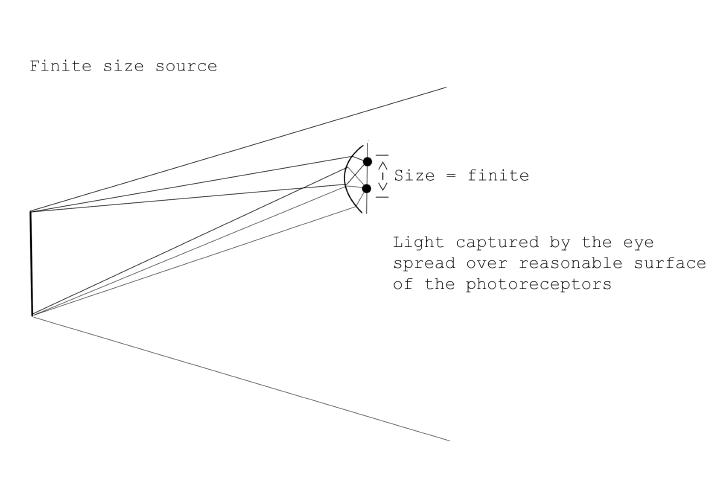
The image of the object on the eye's photoreceptors will be not just a point, but an object the same shape as the object so of reasonable length and width and thus the light emitted by the lamp is spread over a much larger number of photoreceptors than in situation 3.
The amount of light drops off not quite with inverse square of the distance, but more like 1/(r+r0)^2, where r0 is the distance to the virtual point source that lies some distance behind the lamp (in case of a taillamp on a bicycle: in the direction of the headlamp of the bicycle, so the reverse direction from where the light shines to).
Situation 2: A light source that emits truly parallel light (this is what lasers can do)
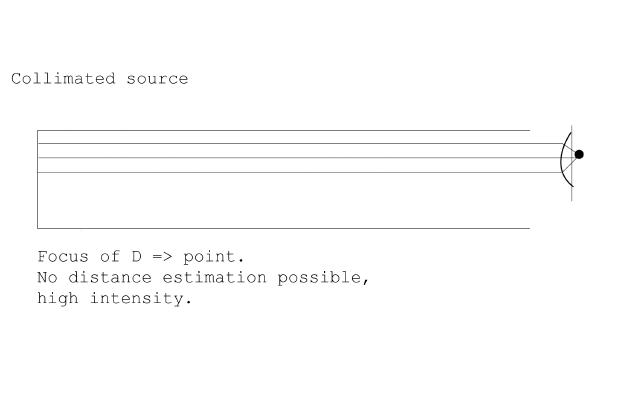
This shows when you focus at infinity you will see a point, but at any other distance it will be blurry. Now think about this: there is no way to estimate distance. The object that you see from the light alone, you cannot focus on, obviously, because the light could be 5 m or 100m away, what you see is always the same because the light is the same however far the object would be.
Another issue is under which circumstances you can see the object: One or both of your eyes must fall in the beam, otherwise you won't see anything at all! This only happens if you are within a region as wide as the lamp which in case of a taillamp is about 10cm. Move more than that the side and you see nothing.
So the amount of light on the photoreceptors is constant when your eye is within the beam, zero otherwise.
All this shows that a truely collimated beam is not useful.
Situation 3: A point source
The emitting surface is almost zero, so luminance is very high, and luminous intensity (when doing a close range measurement, however this is probably not the way taillamps are normally measured but that's another matter) is very high because a lot of light goes into any given direction from the point source (which means the lamp sends far more light in a specific direction from a given similar size emitting-surface area as the lamp in situation 1 which has a large emitting surface). At large distance a measurement of luminous intensity will not differ from that of a taillamp with larger emitting surface of course [ I will add some pictures to clarify these differences when measuring close by and far away ]
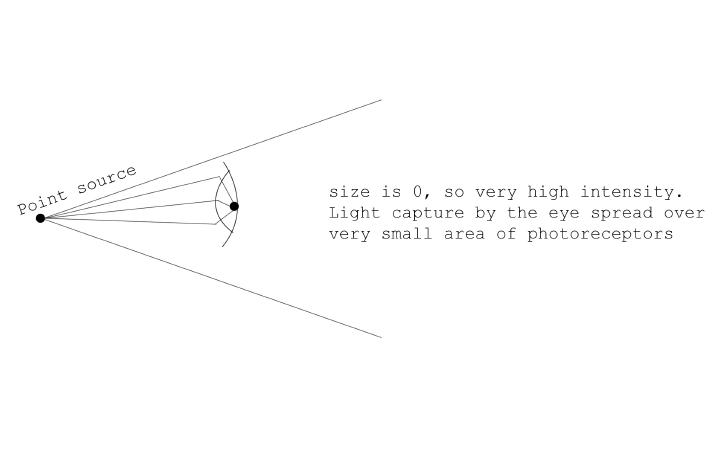
The image of the point will become a point (barring distortion from a non perfect lens, and when you focus on an object at a different distance than the light emitter it will also not be a point but a bigger blurry dot) and thus fall on a small number of photoreceptors.
The amount of light on the photoreceptors drops off with the inverse square of the distance...
The 3 different types compared with some example calculations of the lux values
As above:
- lamp 1 = with large emitting surface
- lamp 2 = collimated light
- lamp 3 = point source:
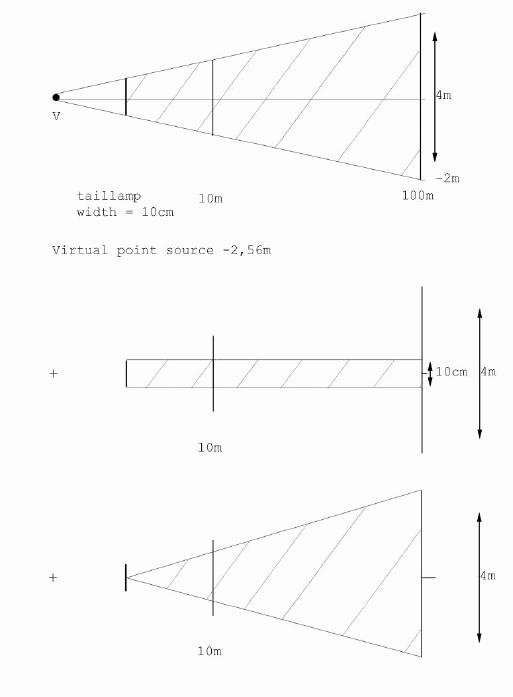
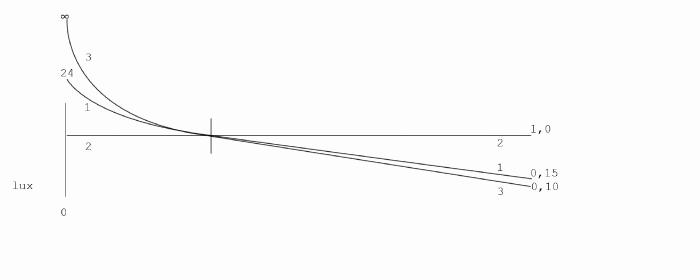
Where the emitting surfaces start at the same point, and the intensities in lux are chosen to be equal at 10 metres.
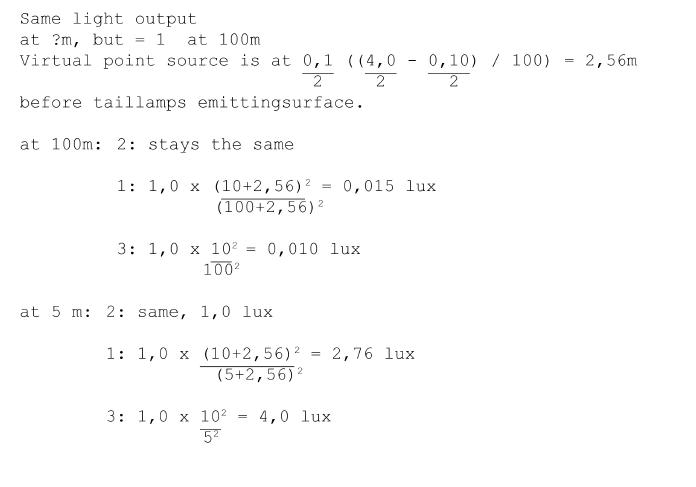
So the intensity for a large emitter drops off less than than a point source, although for visibility we need to take into account that the point source is projected onto a smaller number of photoreceptors. However, (1) at long distance there is not much of a difference between a point source and a larger lamp (see the next section) and (2) just about any taillamp I have tried is fairly well visible at long distance even in case they have a diffuse beam without a strong narrow component for long distance visibility. More than what even old incandescent taillamps such as the SP15 produced, is not needed to be visible at hundreds of metres.
The real problem is at shorter distances, where with a point source the lux values go sky high and the light is still projected onto a very small spot on the retina. This serves no purpose and only annoys and blinds following traffic (in particular other cyclists).
Why luminance is not of interest at long distance
As I mentioned with my long distance taillamp test of standard StVZO approved taillamps, at some point the annoyance of point light sources drops to where they are no longer annoying. So, why is this? Well, I think movement of the emitter and/or observer already nullifies a lot of the 'advantage' in visibility from a high luminance at longer distances (say more than 35m, just an estimate from the drop in annoyance of taillamps with a almost-point-source, in my tests). Other reasons are certain: The eye is not perfect, and imperfections in the lens (or because the lens gets less clear with age) will spread the light over more receptors. Receptors need not be perfect either. The resolving power of the eye is about 1mm at 1.5m or about 6.7cm at 100m. 6.7cm is close to the width of a rack mounted taillamp, which are about 10cm wide, thus a point source and source with large emitting area will be hard to distinguish at 100m, in having a size but also in peak intensity, despite the fact that the light of the point source is mapped to a point. And thus a point source (situation 3) will definitely be worse in the aspect of visibility at distances of about 150m and more, with the same power as a source of light with large emitting area (situation 1).
Difference of light intensities is the main problem in getting blinded
Physiological
As the tests with the Magichine and Lupine Betty showed, the amount of light coming from a headlamp is not the only factor in why it can blind you, but what really causes blinding is when there is a big difference in light intensity. So a headlamp with strong beam in the centre but weak outside that, can cause blinding if the centre part shines in your eyes because the light intensity coming from reflected light off of the road and green is weak. If the beam is very even then blinding doesn't take place because there is enough intensity of the light reflected off of the road/green from that light so that the direct light does not cause you to see nothing. This was shown in my tests of the Magicshine and Lupine Betty (which did not blind me despite producing 3 times as much light as the Magicshine).
This is the same with taillamps. Taillamps shine without lighting up the surroundings, so there is a big difference in light intensity at night: The taillamp itself is surrounded by almost-darkness. For taillamps without proper optics that shine the light from a point source, the difference is enormous. Look at such a blinding taillamp and try to see what you can really see. I noticed that it is very hard to properly see the things in the area around the taillamp (e.g. the rear rack of the bicycle) and what is behind it. Focussing on an almost-point source is very difficult, what invariably happens is that you focus on something nearby (such as the rear rack) illuminated by ambient light, then you see the point source as a point. The flaring even when focussed is why there is not a good way to focus on the point source, you can't get it 'sharp' (good contrast with sharp edges).
Summary: for point sources there are the problems of:
- (1) too high contrast (difference between light and dark is too high).
- (2) it is hard to focus the light source.
- (3) and of course there is the problem that distances cannot be estimated as a point source is a point source at any distance (and judging distance from intensity doesn't work well as you don't have reference values in your head...).
Note that (2) and (3) are part of the same issue of focus being dependent on distance estimating.
Psychological
A blinding, annoying light attracts attention, thus blinding you in a psychological sense...
Result: Dual blinding
So the blinding takes place in 2 ways: Your attention gets taken away to that point source, and your vision is impaired from that point source.
Conclusion
So what do you want? Well, what you want for a taillamp is a large illuminating surface that puts out an almost collimated beam, i.e. a beam in a tight cone: From each point of the surface of the lamp, you want a tight cone (8 degrees is already wide), which should be chose to be wide enough at long distances (at 100m the beam will be 14 m wide with an 8 degree beam, wide enough even for meandering roads), and add to that more light at lower intensity going in various directions for short distance visibility. (Note: 'add' is what I mean with 'and also' on the main page where I mention what a good taillamp should be like, other interpretations don't make sense)
Headlamps are dual purpose: To be seen and to see. For the 'to be seen' part (= light that gets directly into the eyes of oncoming traffic, i.e. the light from the headlamp above the horizon) the above considerations should be looked at. For the 'to see' part, you simply want as much light on the road as possible, luminous intensity is of no interest there as what others will see from the part of the beam that hits the ground, is reflected light off of surfaces which are usually fairly diffuse (plants, ground, road surface). So what oncoming traffic sees from the part of your beam that goes below the horizon, is similar to situation 1 (the whole road, green etc. is then an emitter, namely with the light being the light from the headlamp which is scattered by the road surface).
Last modified: Mon Feb 24 18:48:34 CET 2014





